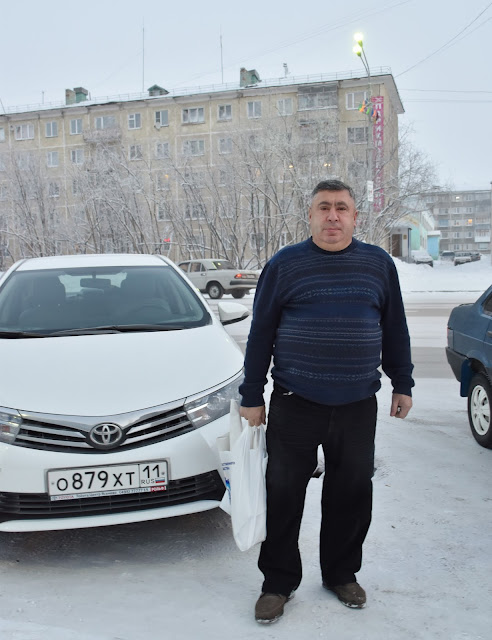Last Friday, I went on a tour with Pyotr, a former miner now working as
a taxi driver, to have a look at the settlements and coal mines around
Vorkuta.
There were 13 mines at the height of the Soviet Union, but today only 4 are still working. With the closure of the mines, many settlements have been partially or completely abandoned, leaving behind a landscape of eerie ghost-cities.
On our tour, we came upon an installation of the Russian space defense forces, and a newly established Gazprom basecamp.
From here, workers and engineers leave by helicopter to Gazprom's installations in the tundra.
Then we came to the Severnaya mine, where 36 miners lost their lives in February this year because of a methane gas explosion. Pyotr, who had worked in the Severnaya mine himself and had known some of the miners that lost their lives, was visibly touched when removing the snow from some of the name plates. After the accident, the mine was flooded, and is now closed.
While some settlements are still partially inhabited, others were completely empty.
When we came to a prison camp, 6 fresh coffins were standing outside the gate, with Pyotr remarking dryly: “Prisoners here die fast”. Shortly afterwards we came to a memorial for Stalin’s prison camps, behind which a field of small crosses extended into the tundra.
And still, despite all the harshness, the landscape is sometimes of great, otherworldly beauty.
Pyotr had come here in the 1990s from Lugansk in Ukraine, because the pay was better. And although he now could leave, he doesn’t want to. “The fish here is good, Misha”. So I had to buy a couple of kilos to bring to my family and friends for Christmas.
There were 13 mines at the height of the Soviet Union, but today only 4 are still working. With the closure of the mines, many settlements have been partially or completely abandoned, leaving behind a landscape of eerie ghost-cities.
On our tour, we came upon an installation of the Russian space defense forces, and a newly established Gazprom basecamp.
From here, workers and engineers leave by helicopter to Gazprom's installations in the tundra.
Then we came to the Severnaya mine, where 36 miners lost their lives in February this year because of a methane gas explosion. Pyotr, who had worked in the Severnaya mine himself and had known some of the miners that lost their lives, was visibly touched when removing the snow from some of the name plates. After the accident, the mine was flooded, and is now closed.
While some settlements are still partially inhabited, others were completely empty.
When we came to a prison camp, 6 fresh coffins were standing outside the gate, with Pyotr remarking dryly: “Prisoners here die fast”. Shortly afterwards we came to a memorial for Stalin’s prison camps, behind which a field of small crosses extended into the tundra.
And still, despite all the harshness, the landscape is sometimes of great, otherworldly beauty.
Pyotr had come here in the 1990s from Lugansk in Ukraine, because the pay was better. And although he now could leave, he doesn’t want to. “The fish here is good, Misha”. So I had to buy a couple of kilos to bring to my family and friends for Christmas.






































































